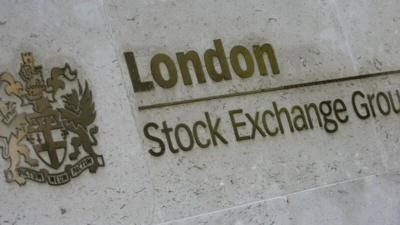The Fed just signaled rate cuts could be coming. But Wall Street isn’t in the clear
A version of this story first appeared in CNN Business’ Before the Bell newsletter. Not a subscriber? You can sign up right here. You can listen to an audio version of the newsletter by clicking the same link.
The Federal Reserve finally acknowledged that the current rate-hiking cycle could soon be over, sending the Dow Jones Industrial Average to a record high on Wednesday.
That doesn’t mean investors are out of the woods just yet.
The Fed on Wednesday paused interest rates for the third consecutive time, keeping the benchmark lending rate at a 22-year high. The central bank also projected three rate cuts next year, and signaled that it might be done raising rates, though it didn’t take future rate hikes off the table.
“We believe that we are likely at or near the peak rate for this cycle,” Chair Jerome Powell told reporters at the post-meeting press conference.
That’s a sharp pivot from the Fed’s unwaveringly hawkish tone, or preference for tightening monetary policy, that it has struck since the central bank began its aggressive pace of interest rate hikes in March 2022.
Inflation reports in recent months have shown signs of continued slowing. While the labor market remains resilient, it hasn’t shown the gangbusters growth it did earlier this year that sparked fears the Fed would raise rates higher to tame inflation. At the same time, consumer spending has cooled down — but not to worrying levels.
While investors have yet to parse the Fed’s favorite inflation gauge, the Personal Consumption Expenditures Index, for November, recent key reports suggest that it’ll also show signs of moderating prices, says Eric Green, chief Investment officer at Penn Capital Management.
Investors cheered the Fed’s comments on Wednesday, sending stocks sharply higher. The blue-chip Dow Jones Industrial Average closed at a new all-time high, while the S&P 500 index is within striking distance of a record high.
Despite the market’s euphoria, however, there still remain key challenges ahead in the Federal Reserve’s fight against inflation.
Inflation is still high. Inflation is still well above the Fed’s 2% goal, and is unlikely to reach that target until 2026, according to the central bank’s projections. Powell said Wednesday that the Fed could still cut rates before inflation hits that level, since waiting too long to ease rates runs the risk of putting the economy into a tailspin.
Still, Powell has warned before that he’s loath to repeat the mistake made by Arthur Burns’ Fed, which cut rates prematurely and forced the Paul Volcker-led central bank to aggressively raise rates later and help trigger back-to-back recessions.
The Fed likely won’t cut rates as quickly or sweepingly as Wall Street expects. Investors also might be getting ahead of themselves when it comes to their rate cut expectations. Wall Street is pricing in seven rate cuts next year, according to the CME FedWatch Tool.
Plus, rate cuts won’t necessarily translate into a boon for the economy: While the Fed could start cutting rates because inflation has come down enough that there’s no need for tight monetary conditions, the Fed could also ease policy if the economy downturns, says Ken Moraif, chief executive at Retirement Planners of America.
A recession next year is still possible. Chair Powell said Wednesday that the economy could still enter a recession in 2024, though he’s confident the economy isn’t currently in one.
And while soft landing optimism has grown in recent months, some investors say that they’re not convinced just yet.
“The tone today was almost as though [the Fed is] expecting the perfect landing, well beyond expectations of a soft landing,” wrote Alex McGrath, chief Investment officer at NorthEnd Private Wealth, in a note on Wednesday. “I cannot help but wonder and hope that Chairman Powell’s tenure turns out better than Arthur Burns’ did.”
US wholesale inflation dropped to 0.9% annually in November
Tumbling energy prices helped to bring US wholesale inflation down below pre-pandemic levels and to its second-lowest rate this year, reports my colleague Alicia Wallace.
The Producer Price Index, which measures the average price changes that businesses pay to suppliers, rose at a slower pace of 0.9% for the 12 months ended in November, down from a 1.2% annual increase in October, according to Bureau of Labor Statistics data released Wednesday. November’s 0.9% gain is also well below the 2011 to 2019 average of 1.68%, BLS data shows.
On a monthly basis, prices were unchanged. That’s up from a 0.4% decline the month before, when energy prices fell 6.5% and gasoline prices sharply contracted by 15.3% over the month.
In November, energy prices dropped by a more muted 1.2%. That downward swing and a 0.5% drop in transportation and warehousing costs offset a 0.6% increase in food.
Economists expected PPI to inch up 0.1% from October and rise 1% on an annual basis, according to Refinitiv estimates.
Read more here.
The Fed doesn’t actually control its key interest rate. Here’s what does
The Federal Reserve has a lot of sway over the US economy and financial markets. But there’s one thing it doesn’t have: the ability to get interest rates to the exact level it wants.
How could that be? Doesn’t the Federal Reserve control interest rates?
Actually, no, it doesn’t.
While you may have read that Fed officials voted to raise, lower or hold interest rates steady after their monetary policy meeting, what they’ve actually voted on is the target range for the federal funds rate.
That range determines the actions the central bank will take behind the scenes through the use of its multitrillion-dollar balance sheet to influence borrowing costs across the economy on everything from mortgages to commercial loans.
Read more here.
Maybe You Like
London Stock Exchange urged to do more to hold onto retail traders
The UK stock market needs to improve investor communication and engagement in order to retain its individual traders, according to a report from online trade and investor provider CMC Markets. ADVERTISEMENTUK retail investors are increasingly...
Hargreaves Lansdown rejects private equity takeover bid
The UK investment platform says the offer from a group including the Abu Dhabi Investment Authority undervalues the firm. ADVERTISEMENTHargreaves Lansdown has rebuffed a takeover proposal worth £4.67 billion (€5.48 billion) made...
Ferrovial set to offload UK regional airports amid Heathrow deal uncertainty
Ferrovial is planning to sell its stake in three UK regional airports amid difficulties in finalising its £2.4bn sale of a 25% stake in Heathrow. ADVERTISEMENTSpanish infrastructure company Ferrovial is reportedly putting up for sale...



























